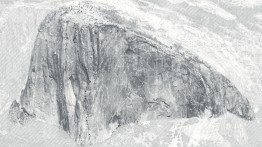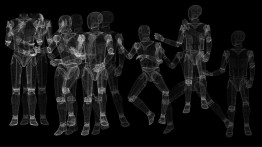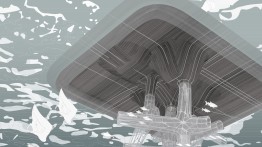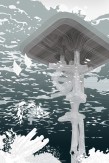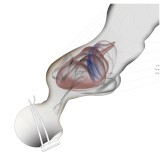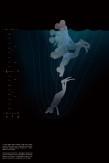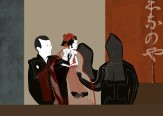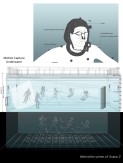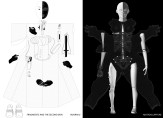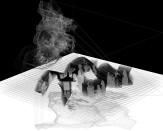MASTER OF SCIENCE IN ARCHITECTURE SPRING 2023
GRADUATE RESEARCH DESIGN STUDIO II
Diana Agrest, The Irwin S. Chanin Distinguished Professor
The Body: Corporeal Boundaries and Spatial Intersections
The subject of the body has deep roots in Western architecture theories from the texts of the Renaissance reading of Vitruvius. From Alberti to Francesco di Giorgio Martino and Filarete, the body has been a referent, a tool, and a construction in which the body (of man) is both a metaphoric and a metonymic construction having perfect proportions and harmony based on nature in whole and in part. We can fast-forward to the culture of disembodiment brought about as a result of cybernetics, information, mediatization, and in general, virtual reality, in a world that is nothing but simulacrum and in which the body becomes in its many forms of representation a simulacrum itself.
In the long stretch in between there are all forms of Western architectural constructions of the body from Ernst Neufert’s Architects’ Data of 1936 to The Modulor by Le Corbusier of 1945 and 1955. One could certainly say a lot about these socially biased narratives of control of the body in space as they relate to the body as a machine in a prevailing technocratic ideology, and the body as a tool for the consumption and control of the space of habitation. But breaking the limits of those inherited approaches, one must ask what body is the body in question?
And then there is the question of the places and spaces affected by and/or affecting the body and institutionalized modes of control and restriction—or one could look at the body, in its corporeality and the pushing of the limits of the body itself in extreme environmental conditions under water or in outer space or in rock climbing or cave explorations or in competitive sports as seen in the Olympics. Or the overcoming of its boundaries through the means of possible extensions, from those related to the senses to parts of the entire body through the possibilities afforded by constantly changing and advancing technologies that have gone from the mechanical to the digital. This includes all forms of prosthetic devices, some remedial and some just expansive per se in a cyborgian transformation as Haraway so vividly prognosticated. Or the body relative to the myriad organisms that interact with it and affect it from within and from without, as the body relates to questions under the general rubric of health and the many different modes the body/machine interaction is once more enacted.
But again, what body? The question is that of difference as opposed to the universalization of an abstract (male) body—differences of all kinds, from genetic to cultural, including questions of sex, gender, race or ethnicity, the labeling of bodies, but which in fact touch on the most profound forces that travel through fluids and synapses traversing the whole body in billions of possible routes, rhythms, and outcomes, each unique. This includes the transformation of the body in the process of reproduction, all this in its counterintuitive packaging.
But this body is affected if not completely determined by socio-political, economic, cultural, ideological, and physical environments and enacted in diverse places and modes habitation—from the physical body to a culture of disembodiment, in the cyberspace we inhabit, exacerbated at the present time.
This studio approaches the question of what bodies are we talking about, where are these bodies, and how are those boundaries and spatial intersections enacted in articulations and intersecting boundaries from a critical perspective. This exploration was developed in specific contexts in which students found their own individual interests and narratives addressing both the body itself and the environments where they operate as a creative and seamless process with no separation between research and project in which questions of representation have an essential role.
< Back to Selected Graduate Design Studio Projects
Projects
-

From the Deep Sea to the Mine Pit
-

Atmospheric Embrace: A Sublime Room above the Clouds
-

On Bunraku: Dis-Embodiment and Representation of the “Body” in Fragments
Back
From the Deep Sea to the Mine Pit
Tsung-Han Lin
This project focuses on the study of the effects of extreme conditions on the human body as well as their subsequent effects on individuals and societies. It explores two contrasting examples:
Haenyeo (the professional women divers on Jeju Island) dive to the bottom of the ocean, subjecting themselves to great water pressure that compresses their lungs. This compression causes nitrogen to change to a liquid state, posing a health risk to divers as it enters their joints and muscles. Haenyeo are trained from an early age to manage their dive time and technique.
In illegal gold mining in Paracale, Philippines, young miners face a more severe environment. In addition to water pressure, underwater miners are exposed to the fumes and toxic metals of the illegal gold mining industry. Their vision is obstructed by smog and dust accumulates in their lungs. This forces them to use their sense of touch to orient themselves, increasing their risk.
This project proposes using the miners’ familiar body movements and spatial and sensory experience to master diving skills. The purpose is to provide an alternative life for these young miners through professional diving techniques and marine ecology education beyond gold mining, enabling them to escape the dangers of compressor mining and break the cycle of their challenging lives.
Atmospheric Embrace: A Sublime Room above the Clouds
Daniel Matallana
This project looks at the body in nature—specifically rock climbing. While embarking on big wall climbs, climbers enter a liminal space where they are exposed to magnified natural forces like storms, wind, rain, fog, etc.; uncertain weather patterns; diminishing levels of oxygen; and the conscious or unconscious psychological effects of being in a high-risk situation. With a minimum amount of gear, the body navigates vertical space through systems of tension. Ropes and harnesses are clipped to points anchored in the rock, while the climber’s body operates by pulling on the skeleton through the tendons. Specific elements of gear, like climbing shoes, augment the body’s geometry to allow for more precise interactions with the rock. On rock walls which cannot be climbed in a single day, climbers make overnight sleeping stops using a portable shelter that hangs from the rock surface. The outcome of this research is a proposal for a lightweight, inflatable shelter for these expeditions. 3D-printed ribs provide the formwork for a structure of air that hangs from a single point; a sublime room above the clouds.
On Bunraku: Dis-Embodiment and Representation of the “Body” in Fragments
Chenyan Wang
Bunraku is a form of traditional Japanese puppet theatre, founded in Osaka in the beginning of the 17th century. Oversized puppets, standing about three to four feet high, are deftly manipulated by three puppeteers dressed in black, one with his face bared (the Master), the other two veiled. An explication of “body in pieces” and its wholeness and reconstructability is presented through an assemblage of delicate and discontinuous movements. The three puppeteers become a collective body.
The traditional Bunraku puppetry shows incredible similarities with the advanced motion-capture technology. The actor becomes the marionette and the puppeteer at the same time in the process of impersonation. Combined with mo-cap technology, a new Bunraku is created. The fragments of puppets lose their intimacy with the puppeteers and create a fourth collective body. In this way, we can rethink the visibility of the invisible and fragmented bodies in cultural representation; represent the body’s tangible abstraction by rejecting the antinomy of puppet/puppeteer, animate/ inanimate, inside/outside; and banish the concept hidden behind all animation. Bodily ‘wholeness’ always involves an immaterial supplement, an absent presence, which both completes and leaves open the fourth body-as-conception.

